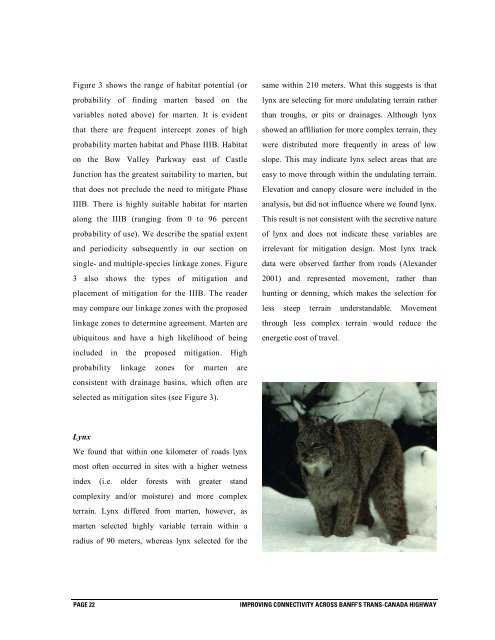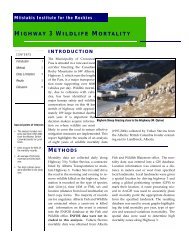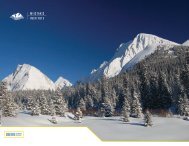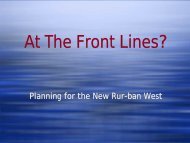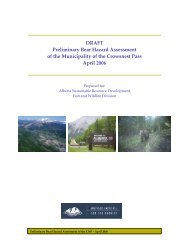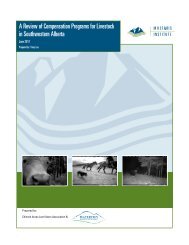A GIS based approach to restoring connectivity across Banff's Trans ...
A GIS based approach to restoring connectivity across Banff's Trans ...
A GIS based approach to restoring connectivity across Banff's Trans ...
You also want an ePaper? Increase the reach of your titles
YUMPU automatically turns print PDFs into web optimized ePapers that Google loves.
Figure 3 shows the range of habitat potential (or<br />
probability of finding marten <strong>based</strong> on the<br />
variables noted above) for marten. It is evident<br />
that there are frequent intercept zones of high<br />
probability marten habitat and Phase IIIB. Habitat<br />
on the Bow Valley Parkway east of Castle<br />
Junction has the greatest suitability <strong>to</strong> marten, but<br />
that does not preclude the need <strong>to</strong> mitigate Phase<br />
IIIB. There is highly suitable habitat for marten<br />
along the IIIB (ranging from 0 <strong>to</strong> 96 percent<br />
probability of use). We describe the spatial extent<br />
and periodicity subsequently in our section on<br />
single- and multiple-species linkage zones. Figure<br />
3 also shows the types of mitigation and<br />
placement of mitigation for the IIIB. The reader<br />
may compare our linkage zones with the proposed<br />
linkage zones <strong>to</strong> determine agreement. Marten are<br />
ubiqui<strong>to</strong>us and have a high likelihood of being<br />
included in the proposed mitigation. High<br />
probability linkage zones for marten are<br />
consistent with drainage basins, which often are<br />
selected as mitigation sites (see Figure 3).<br />
same within 210 meters. What this suggests is that<br />
lynx are selecting for more undulating terrain rather<br />
than troughs, or pits or drainages. Although lynx<br />
showed an affiliation for more complex terrain, they<br />
were distributed more frequently in areas of low<br />
slope. This may indicate lynx select areas that are<br />
easy <strong>to</strong> move through within the undulating terrain.<br />
Elevation and canopy closure were included in the<br />
analysis, but did not influence where we found lynx.<br />
This result is not consistent with the secretive nature<br />
of lynx and does not indicate these variables are<br />
irrelevant for mitigation design. Most lynx track<br />
data were observed farther from roads (Alexander<br />
2001) and represented movement, rather than<br />
hunting or denning, which makes the selection for<br />
less steep terrain understandable. Movement<br />
through less complex terrain would reduce the<br />
energetic cost of travel.<br />
Lynx<br />
We found that within one kilometer of roads lynx<br />
most often occurred in sites with a higher wetness<br />
index (i.e. older forests with greater stand<br />
complexity and/or moisture) and more complex<br />
terrain. Lynx differed from marten, however, as<br />
marten selected highly variable terrain within a<br />
radius of 90 meters, whereas lynx selected for the<br />
PAGE 22<br />
IMPROVING CONNECTIVITY ACROSS BANFF’S TRANS-CANADA HIGHWAY


